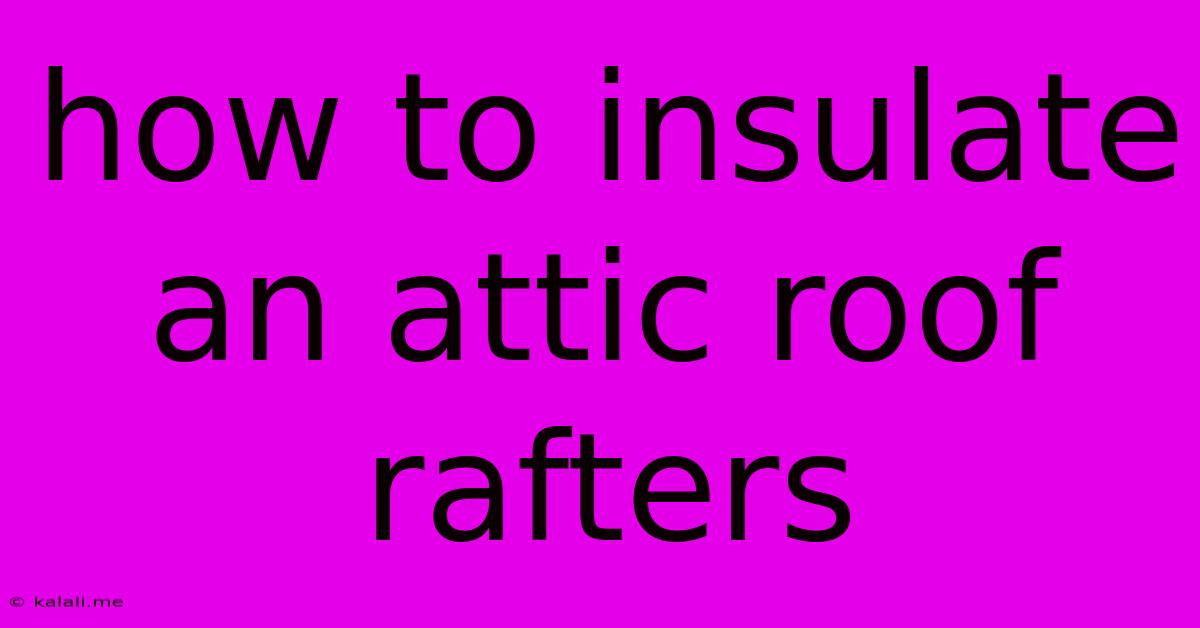How To Insulate An Attic Roof Rafters
Kalali
May 25, 2025 · 3 min read

Table of Contents
How to Insulate Attic Roof Rafters: A Comprehensive Guide
Meta Description: Learn how to properly insulate your attic roof rafters to improve energy efficiency, reduce energy bills, and enhance comfort. This comprehensive guide covers materials, methods, and best practices.
Insulating your attic roof rafters is a crucial step in improving your home's energy efficiency. A poorly insulated attic can lead to significant heat loss in winter and heat gain in summer, resulting in higher energy bills and discomfort. This guide provides a step-by-step approach to effectively insulating your attic rafters, maximizing your home's comfort and minimizing your environmental impact.
Understanding Attic Insulation
Before diving into the installation process, understanding the different types of attic insulation is vital. The most common types include:
-
Batt Insulation: This comes in rolls or batts and is typically made of fiberglass or mineral wool. It's easy to install and relatively inexpensive, making it a popular choice for DIY projects. Consider its R-value (resistance to heat flow) when selecting the appropriate thickness. Higher R-values mean better insulation.
-
Loose-Fill Insulation: This includes cellulose, fiberglass, and mineral wool, blown into the attic space. It's excellent for filling irregular areas and hard-to-reach spaces, providing a consistent insulation layer. Professional installation is often recommended for loose-fill insulation.
-
Spray Foam Insulation: This is a two-part liquid that expands when sprayed, creating a seamless air barrier. It offers superior insulation and air sealing properties, but is typically more expensive and requires professional installation.
Choosing the right insulation type depends on your budget, attic access, and desired level of insulation.
Preparing for Attic Rafter Insulation
Proper preparation is crucial for a successful insulation project. Before starting, ensure you have:
- Safety Gear: Wear protective clothing, including gloves, eye protection, and a dust mask, particularly when working with fiberglass insulation.
- Necessary Tools: You'll likely need a utility knife, measuring tape, safety glasses, and potentially a staple gun (depending on insulation type).
- Sufficient Insulation: Calculate the amount of insulation needed based on your attic's dimensions and the desired R-value. Consult energy efficiency guidelines or a professional for accurate calculations.
- Ventilation: Ensure adequate attic ventilation is in place before and after insulation installation. Proper ventilation prevents moisture buildup, which can lead to mold and mildew growth.
Installing Batt Insulation Between Rafters
Batt insulation is a popular DIY option. Here's how to install it:
-
Measure and Cut: Measure the space between each rafter and cut the batt insulation to the correct size. It's better to slightly overestimate than underestimate.
-
Fit and Tuck: Carefully fit the insulation snugly between the rafters, ensuring there are no gaps. Tuck the insulation tightly into corners and crevices.
-
Staple (if needed): Some batts have flanges that can be stapled to the rafters for extra security. This helps prevent settling and sagging.
-
Repeat: Repeat steps 1-3 for all rafters. Ensure consistent coverage across the entire attic space.
Installing Loose-Fill Insulation
Loose-fill insulation requires professional equipment. However, understanding the process is useful:
-
Professional Installation: Hire a qualified insulation contractor for this method.
-
Even Distribution: The contractor will use specialized equipment to evenly distribute the loose-fill insulation throughout the attic space. This ensures consistent coverage and avoids hot spots.
-
Air Sealing: Loose-fill insulation often includes air sealing measures to further improve energy efficiency.
Maintaining Your Attic Insulation
Once the insulation is installed, regular maintenance is important:
-
Inspect for Damage: Periodically inspect the insulation for any signs of damage, settling, or moisture.
-
Address Pests: Monitor for pest infestation, as rodents and insects can damage insulation and create pathways for air leaks.
-
Ventilation Check: Ensure attic ventilation remains adequate to prevent moisture buildup.
By following these steps and choosing the appropriate insulation type, you can effectively insulate your attic roof rafters, creating a more comfortable and energy-efficient home. Remember to always prioritize safety and consider professional installation if needed. The long-term benefits of proper attic insulation – reduced energy bills, increased comfort, and enhanced home value – far outweigh the initial investment.
Latest Posts
Latest Posts
-
How To Curve A Bowling Ball
May 25, 2025
-
What Temp To Season Cast Iron
May 25, 2025
-
Garage Door Opener Does Not Work
May 25, 2025
-
How To Turn Off Ringer On Mac
May 25, 2025
-
Is The Word Hell A Curse Word
May 25, 2025
Related Post
Thank you for visiting our website which covers about How To Insulate An Attic Roof Rafters . We hope the information provided has been useful to you. Feel free to contact us if you have any questions or need further assistance. See you next time and don't miss to bookmark.